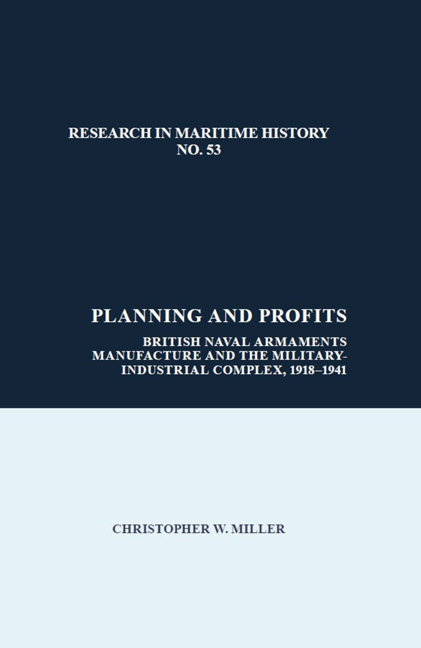 Planning and Profits
Planning and Profits Book contents
- Frontmatter
- Contents
- Acknowledgements
- About the Author
- List of Tables and Figures
- List of Illustrations
- List of Abbreviations
- A Note on Definitions
- Part One Introduction
- Part Two Industry and the Navy before Manchuria, and the Establishment of the Warshipbuilders’ Committee, 1919–1931
- Part Three The Formation of a National Government, the Far East, and the PSOC Approach to Industry, 1931–1934
- Part Four The Ultimate Potential Enemy and Rearmament Planning, 1934–1936
- Part Five The Inskip Era and War, 1936–1941
- 9 The Minister for Coordination of Defence and Early Rearmament, 1936–1937 175
- 10 Later Rearmament and War Supply Organisation, 1937–1941
- Conclusion and Retrospective
- Appendices
- Bibliography
- Index
9 - The Minister for Coordination of Defence and Early Rearmament, 1936–1937 175
from Part Five - The Inskip Era and War, 1936–1941
- Frontmatter
- Contents
- Acknowledgements
- About the Author
- List of Tables and Figures
- List of Illustrations
- List of Abbreviations
- A Note on Definitions
- Part One Introduction
- Part Two Industry and the Navy before Manchuria, and the Establishment of the Warshipbuilders’ Committee, 1919–1931
- Part Three The Formation of a National Government, the Far East, and the PSOC Approach to Industry, 1931–1934
- Part Four The Ultimate Potential Enemy and Rearmament Planning, 1934–1936
- Part Five The Inskip Era and War, 1936–1941
- 9 The Minister for Coordination of Defence and Early Rearmament, 1936–1937 175
- 10 Later Rearmament and War Supply Organisation, 1937–1941
- Conclusion and Retrospective
- Appendices
- Bibliography
- Index
Summary
To be generous to the National Government's track record on defence policy between 1931 and 1935, the desire to keep publicity of deficiency and rearmament plans to a minimum was not wholly irrational. The issue was that the political and economic case for limited rearmament progressively strengthened from mid-1934, and not doing so began, by 1935, to badly hamper the development of an industrial skills and facilities base. Nevertheless, it was not entirely negative. A more welcome side effect of “planning without spending” was the involvement of Weir, Lithgow and Balfour with the CID, although this advantage could arguably have been better used by implementing policies like educational orders at an earlier stage. Of course, Lithgow used his involvement to take calculated risks for himself, so the net result was still the preservation of at least some industrial capacity that might otherwise have been lost.
If one can provide reasonable excuses for government inaction until 1935, it becomes harder from 1936. That year should, in theory, have been when planning and action finally came together, when much red tape was cut, when industrial deficiencies were properly rectified, and when rearmament began in earnest. Yet the National Government – following the Second White Paper's publication – still took several months to get a firm grip on rearmament policy and made some inexplicable mistakes that negated much of the positive work in earlier years.
Appointment of Minister for Coordination of Defence and DPR Developments
The National Government's first major step following the March announcement of rearmament was to appoint a new minister to oversee the increasingly complex and gargantuan CID organisation. Sir Thomas Inskip was installed as the newly-created Minister for Coordination of Defence” (MFCD) ten days after the White Paper was announced in Parliament. In principle, this was a sensible move, although it was at least a year too late. Moreover, just as the content of the Second White Paper had only taken shape in the weeks preceding publication, the decision that a new minister was necessary was similarly hurried.
- Type
- Chapter
- Information
- Planning and ProfitsBritish Naval Armaments Manufacture and the Military-Industrial Complex, 1918–1941, pp. 175 - 197Publisher: Liverpool University PressPrint publication year: 2018


